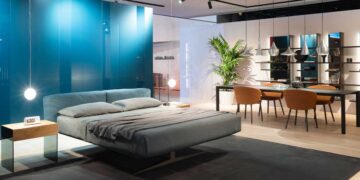
Choosing the right wood wall panels can significantly elevate the ambiance of any room, turning it into a statement of sophistication and warmth, especially when used to create a feature wall. Whether you’re aiming for a rustic feel with reclaimed wood or prefer a modern edge with smooth, treated panels, wood offers remarkable versatility and aesthetic appeal.
This design choice not only enhances the visual interest of a space but also contributes to insulation and durability. Suitable for both residential and commercial environments, wood feature walls can serve as the focal point that ties the entire decor, merging functionality with creative flair.
Let’s explore some of the top wood pannelling for walls, to help you make the best decision between different species.
Spotted Gum Timber
Spotted Gum is a superb option for interior wood paneling, particularly for feature walls, due to its unique combination of visual appeal and practical benefits. Its inherent elegance is showcased through a grain pattern which is very rich with a varied color palette, ranging from light browns to deep reds, making it a versatile choice that complements a broad spectrum of interior designs.
Moreover, Spotted Gum is highly durable and resistant to wear, making it ideal for high-traffic areas. Its natural oils provide resistance against pests and decay, while its acoustic properties can enhance the sound dynamics of a space, making it a popular choice in areas where noise control is important. In summary, Spotted Gum panels enhance the visual appeal of a room and also add to its functionality and longevity.
Western Red Cedar Timber
Western Red Cedar is another excellent choice for interior wood paneling and feature walls, thanks to its distinct characteristics and functional advantages. Its warm tones and straight, uniform grain create a visually calming and inviting aesthetic that adapts easily to various design styles. Western Red Cedar is lightweight and easy to work with, simplifying installation. It is also known for its superior insulative properties, helping to regulate indoor temperatures and reduce energy costs.
Additionally, like Spotted Gum, Western Red Cedar’s natural oils give it a high resistance to moisture, decay, and insect damage, making it durable in a variety of indoor environments. Its acoustic properties also enhance the overall ambiance of a space by dampening sound. With these benefits, Western Red Cedar panels combine beauty with practicality, making them an ideal choice for creating striking and functional interior spaces.

American Oak Timber
American Oak is a superb choice for feature walls, celebrated for its timeless appeal and versatile qualities. This hardwood features a warm, golden-brown color with a distinctive, straight grain pattern that adds a touch of classic elegance to any room. Its consistent texture and uniform appearance make American Oak ideal for creating a seamless, polished look across larger surfaces.
Beyond its aesthetic charm, American Oak is also known for its durability and strength, ensuring that your feature wall not only looks stunning but also stands up well to everyday use. Its adaptability to various finishes allows for a customized look, whether you prefer a natural matte effect or a glossy, refined finish. With its blend of beauty, durability, and flexibility, American Oak is an excellent choice for a feature wall that enhances both the style and functionality of your space.
Ironbark Timber
Ironbark timber is an exceptional choice for feature walls, known for its impressive strength and rich, dark hues. This hardwood boasts a deep, reddish-brown color that adds a sense of warmth and sophistication to any interior space. Its dense, interlocked grain pattern not only enhances its visual appeal but also contributes to its remarkable durability, making it highly resistant to wear and tear. Ironbark’s robust nature makes it particularly suitable for high-impact areas, ensuring that your feature wall remains a striking focal point for years to come.
Additionally, its natural resistance to termites and decay adds to its longevity, making Ironbark a reliable and aesthetically pleasing option for creating a feature wall that exudes both elegance and resilience.

Feature Wall Basics
When designing a feature wall, it’s important to consider both its visual impact and how it harmonizes with the rest of the room. Begin by selecting the right location; the wall you choose should naturally draw attention, such as behind a bed in a bedroom or across from the entryway in a living room.
Choosing the right material and color is vital. Opt for textures and shades that enhance yet contrast with your current decor. For example, bold wallpaper, textured stone, or sophisticated wood paneling can bring depth and personality to a space.
Lighting plays a key role as well. Strategically positioned lighting can accentuate the textures and colors of your feature wall, dramatically transforming the room’s ambiance. Additionally, avoid overcrowding the wall with art or furniture. The feature should stand out on its own, as too many elements can make the space feel cluttered. Finally, consider the scale and proportion relative to the room to ensure that the feature wall harmonizes with the overall design, creating a balanced and inviting space.




















these are stunning! wooden panel walls are definitely in for a comeback. I think a lot of us are striving for that touch of nature at home, and these just feel timeles. It is sad so many people had them in their homes and actually removed them. =(